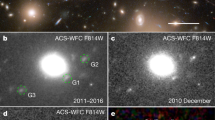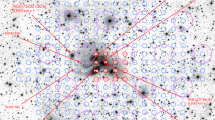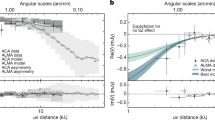Abstract
Clusters of galaxies are the largest known gravitationally bound structures in the Universe. When clusters collide, they create merger shocks on cosmological scales, which transform most of the kinetic energy carried by the cluster gaseous halos into heat1,2,3. Observations of merger shocks provide key information on the merger dynamics, and enable insights into the formation and thermal history of the large-scale structures. Nearly all of the merger shocks are found in systems where the clusters have already collided4,5,6,7,8,9,10,11,12; knowledge of shocks in the pre-merger phase is a crucial missing ingredient13,14. Here, we report on the discovery of a unique shock in a cluster pair 1E 2216.0-0401 and 1E 2215.7-0404. The two clusters are observed at an early phase of major merger. Contrary to all the known merger shocks observed ubiquitously on merger axes, the new shock propagates outward along the equatorial plane of the merger. This discovery uncovers an important epoch in the formation of massive clusters, when the rapid approach of the cluster pair leads to strong compression of gas along the merger axis. Current theoretical models15,16 predict that the bulk of the shock energy might be dissipated outside the clusters, and eventually turn into heat of the pristine gas in the circum-cluster space.
This is a preview of subscription content, access via your institution
Access options
Access Nature and 54 other Nature Portfolio journals
Get Nature+, our best-value online-access subscription
$29.99 / 30 days
cancel any time
Subscribe to this journal
Receive 12 digital issues and online access to articles
$119.00 per year
only $9.92 per issue
Buy this article
- Purchase on Springer Link
- Instant access to full article PDF
Prices may be subject to local taxes which are calculated during checkout



Similar content being viewed by others
Data availability
The data that support the plots within this paper and other findings of this study are available from the corresponding author upon reasonable request.
References
Ryu, D., Kang, H., Hallman, E. & Jones, T. W. Cosmological shock waves and their role in the large-scale structure of the Universe. Astrophys. J. 593, 599–610 (2003).
Bykov, A. M., Dolag, K. & Durret, F. Cosmological shock waves. Space Sci. Rev. 134, 119–140 (2008).
Bykov, A. M., Vazza, F., Kropotina, J. A., Levenfish, K. P. & Paerels, F. B. S. Shocks and non-thermal particles in clusters of galaxies. Space Sci. Rev. 215, 14 (2019).
Markevitch, M. & Vikhlinin, A. Shocks and cold fronts in galaxy clusters. Phys. Rep. 443, 1–53 (2007).
Russell, H. R. et al. Chandra observation of two shock fronts in the merging galaxy cluster Abell 2146. Mon. Not. R. Astron. Soc. 406, 1721–1733 (2010).
Akamatsu, H. & Kawahara, H. Systematic X-ray analysis of radio relic clusters with Suzaku. Publ. Astron. Soc. Jpn 65, 16 (2013).
Ogrean, G. A. & Brüggen, M. First X-ray evidence for a shock at the Coma relic. Mon. Not. R. Astron. Soc. 433, 1701–1708 (2013).
Dasadia, S. et al. A strong merger shock in Abell 665. Astrophys. J. 820, L20 (2016).
Urdampilleta, I. et al. X-ray study of the double radio relic Abell 3376 with Suzaku. Astron. Astrophys. 618, A74 (2018).
Feretti, L., Giovannini, G., Govoni, F. & Murgia, M. Clusters of galaxies: observational properties of the diffuse radio emission. Astron. Astrophys. Rev. 20, 54 (2012).
van Weeren, R. J. et al. The case for electron re-acceleration at galaxy cluster shocks. Nat. Astron. 1, 0005 (2017).
van Weeren, R. J. et al. Diffuse radio emission from galaxy clusters. Space Sci. Rev. 215, 16 (2019).
Markevitch, M., Sarazin, C. L. & Vikhlinin, A. Physics of the merging clusters Cygnus A, A3667, and A2065. Astrophys. J. 521, 526–530 (1999).
Kato, Y. et al. Discovery of a nearby early-phase major cluster merger CIZA J1358.9–4750. Publ. Astron. Soc. Jpn 67, 71 (2015).
Akahori, T. & Yoshikawa, K. Hydrodynamic simulations of merging galaxy clusters: non-equilibrium ionization state and two-temperature structure. Publ. Astron. Soc. Jpn 62, 335 (2010).
Ha, J.-H., Ryu, D. & Kang, H. Properties of merger shocks in merging galaxy clusters. Astrophys. J. 857, 26 (2018).
Akamatsu, H. et al. Suzaku X-ray study of the double radio relic galaxy cluster CIZA J2242.8 + 5301. Astron. Astrophys. 582, A87 (2015).
Akamatsu, H. et al. Suzaku and XMM-Newton observations of the newly discovered early-stage cluster merger of 1E2216.0-0401 and 1E2215.7-0404. Astron. Astrophys. 593, L7 (2016).
Hallman, E. J., Alden, B., Rapetti, D., Datta, A. & Burns, J. O. Probing the curious case of a galaxy cluster merger in Abell 115 with high-fidelity Chandra X-ray temperature and radio maps. Astrophys. J. 859, 44 (2018).
Storm, E., Vink, J., Zandanel, F. & Akamatsu, H. XMM-Newton observations of the southeastern radio relic in Abell 3667. Mon. Not. R. Astron. Soc. 479, 553–561 (2018).
Jones, D. H. et al. The 6dF Galaxy Survey: final redshift release (DR3) and southern large-scale structures. Mon. Not. R. Astron. Soc. 399, 683–698 (2009).
Enßlin, T. A. & Gopal-Krishna Reviving fossil radio plasma in clusters of galaxies by adiabatic compression in environmental shock waves. Astron. Astrophys. 366, 26–34 (2001).
Enßlin, T. A. & Brüggen, M. On the formation of cluster radio relics. Mon. Not. R. Astron. Soc. 331, 1011–1019 (2002).
Hoeft, M. et al. Radio relics in cosmological simulations. J. Astrophys. Astron. 32, 509–517 (2011).
Pinzke, A., Oh, S. P. & Pfrommer, C. Giant radio relics in galaxy clusters: reacceleration of fossil relativistic electrons? Mon. Not. R. Astron. Soc. 435, 1061–1082 (2013).
Vink, J. & Yamazaki, R. A critical shock Mach number for particle acceleration in the absence of pre-existing cosmic rays. M = √5. Astrophys. J. 780, 125 (2014).
Schenck, D. E., Datta, A., Burns, J. O. & Skillman, S. X-ray observations of complex temperature structure in the cool-core cluster A85. Astron. J. 148, 23 (2014).
Akamatsu, H. et al. Properties of the cosmological filament between two clusters: a possible detection of a large-scale accretion shock by Suzaku. Astron. Astrophys. 606, A1 (2017).
Botteon, A. et al. LOFAR discovery of a double radio halo system in Abell 1758 and radio/X-ray study of the cluster pair. Mon. Not. R. Astron. Soc. 478, 885–898 (2018).
Rumsey, C. et al. AMI SZ observation of galaxy-cluster merger CIZA J2242 + 5301: perpendicular flows of gas and dark matter. Mon. Not. R. Astron. Soc. 470, 4638–4645 (2017).
Willingale, R., Starling, R. L. C., Beardmore, A. P., Tanvir, N. R. & O’Brien, P. T. Calibration of X-ray absorption in our Galaxy. Mon. Not. R. Astron. Soc. 431, 394–404 (2013).
Lodders, K., Palme, H. & Gail, H.-P. Abundances of the elements in the Solar System. Landolt Börnstein 4B, 712 (2009).
Vikhlinin, A. et al. Chandra cluster cosmology project. II. Samples and X-ray data reduction. Astrophys. J. 692, 1033–1059 (2009).
Gu, L. et al. Two-phase ICM in the central region of the rich cluster of galaxies A1795: a joint Chandra, XMM-Newton, and Suzaku view. Astrophys. J. 749, 186 (2012).
Shimwell, T. W. et al. The LOFAR Two-metre Sky Survey. II. First data release. Astron. Astrophys. 622, A1 (2019).
Smirnov, O. M. & Tasse, C. Radio interferometric gain calibration as a complex optimization problem. Mon. Not. R. Astron. Soc. 449, 2668–2684 (2015).
Tasse, C. et al. Faceting for direction-dependent spectral deconvolution. Astron. Astrophys. 611, A87 (2018).
Gu, L. et al. A Chandra study of temperature substructures in intermediate-redshift galaxy clusters. Astrophys. J. 700, 1161–1172 (2009).
Diehl, S. & Statler, T. S. Adaptive binning of X-ray data with weighted Voronoi tessellations. Mon. Not. R. Astron. Soc. 368, 497–510 (2006).
Simionescu, A., Böhringer, H., Brüggen, M. & Finoguenov, A. The gaseous atmosphere of M 87 seen with XMM-Newton. Astron. Astrophys. 465, 749–758 (2007).
de Plaa, J. et al. Cold fronts and multi-temperature structures in the core of Abell 2052. Astron. Astrophys. 523, A81 (2010).
Ogrean, G. A. et al. Challenges to our understanding of radio relics: X-ray observations of the Toothbrush cluster. Mon. Not. R. Astron. Soc. 433, 812–824 (2013).
Su, Y. et al. Deep Chandra observations of NGC 1404: cluster plasma physics revealed by an infalling early-type galaxy. Astrophys. J. 834, 74 (2017).
Randall, S. et al. Chandra’s view of the ram pressure stripped galaxy M86. Astrophys. J. 688, 208–223 (2008).
Clarke, T. E., Randall, S. W., Sarazin, C. L., Blanton, E. L. & Giacintucci, S. Chandra view of the ultra-steep spectrum radio source in A2443: merger shock-induced compression of fossil radio plasma? Astrophys. J. 772, 84 (2013).
Korngut, P. M. et al. MUSTANG high angular resolution Sunyaev-Zel’dovich effect imaging of substructure in four galaxy clusters. Astrophys. J. 734, 10 (2011).
Yamada, K. et al. Imaging simulations of the Sunyaev-Zel’dovich effect for ALMA. Publ. Astron. Soc. Jpn 64, 102 (2012).
Erler, J., Basu, K., Trasatti, M., Klein, U. & Bertoldi, F. Evidence for a pressure discontinuity at the position of the Coma relic from Planck Sunyaev-Zel’dovich effect data. Mon. Not. R. Astron. Soc. 447, 2497–2502 (2015).
Basu, K., Vazza, F., Erler, J. & Sommer, M. The impact of the SZ effect on cm-wavelength (1–30 GHz) observations of galaxy cluster radio relics. Astron. Astrophys. 591, A142 (2016).
Acknowledgements
L.G. is supported by the RIKEN Special Postdoctoral Researcher Program. SRON is supported financially by NWO, the Netherlands Organization for Scientific Research. R.J.v.W acknowledges support from the VIDI research programme with project number 639.042.729, which is financed by the Netherlands Organisation for Scientific Research (NWO). F.M. is supported by the Lendület LP2016-11 grant awarded by the Hungarian Academy of Sciences. J.M. acknowledges support by STFC (UK) through the UK APAP network grant ST/R000743/1. The Leiden LOFAR team gratefully acknowledge support from the European Research Council under the European Unions Seventh Framework Programme (FP/2007-2013)/ERC Advanced Grant NEWCLUSTERS-321271.
This research has made use of data obtained from the Chandra Data Archive and the Chandra Source Catalog, and software provided by the Chandra X-ray Center (CXC) in the application packages CIAO, ChIPS and Sherpa. This research is partly based on observations obtained with XMM-Newton, an ESA science mission with instruments and contributions directly funded by ESA Member States and NASA. We thank the staff of the GMRT that made these observations possible. GMRT is run by the National Centre for Radio Astrophysics of the Tata Institute of Fundamental Research. This paper is based in part on data obtained with the International LOFAR Telescope (ILT) under project code LC7_003 and LC9_014. LOFAR is the Low Frequency Array designed and constructed by ASTRON. It has observing, data processing and data storage facilities in several countries that are owned by various parties (each with their own funding sources), and that are collectively operated by the ILT foundation under a joint scientific policy. The ILT resources have benefited from the following recent major funding sources: CNRS-INSU, Observatoire de Paris and Université d’Orléans, France; BMBF, MIWF-NRW, MPG, Germany; Science Foundation Ireland (SFI), Department of Business, Enterprise and Innovation (DBEI), Ireland; NWO, The Netherlands; The Science and Technology Facilities Council, UK; Ministry of Science and Higher Education, Poland. This research made use of the Dutch national e-infrastructure with support of the SURF Cooperative (e-infra 180169) and the LOFAR e-infra group. The Jülich LOFAR Long Term Archive and the German LOFAR network are both coordinated and operated by the Jülich Supercomputing Centre (JSC), and computing resources on the Supercomputer JUWELS at JSC were provided by the Gauss Centre for Supercomputing e.V. (grant CHTB00) through the John von Neumann Institute for Computing (NIC).
Author information
Authors and Affiliations
Contributions
L.G. coordinated the research, led the XMM-Newton, LOFAR and GMRT proposals, reduced and analysed the Chandra and XMM-Newton data, and wrote the manuscript. H.A. led the Chandra proposal and analysed the Suzaku data. T.W.S., H.T.I., R.J.v.W. and F.d.G. performed the radio data reduction and worked on the radio index map. F.M., J.M., I.U. and J.d.P. assisted with the interpretation of the X-ray results, V.P. assisted with the GMRT proposal, H.J.A.R. and J.S.K. provided extensive suggestions on the manuscript.
Corresponding author
Ethics declarations
Competing interests
The authors declare no competing interests.
Additional information
Peer review information: Nature Astronomy thanks Jack Burns and Maxim Markevitch for their contribution to the peer review of this work.
Publisher’s note: Springer Nature remains neutral with regard to jurisdictional claims in published maps and institutional affiliations.
Supplementary information
Supplementary Information
Supplementary Figs. 1–9 and refs. 1–18.
Rights and permissions
About this article
Cite this article
Gu, L., Akamatsu, H., Shimwell, T.W. et al. Observations of a pre-merger shock in colliding clusters of galaxies. Nat Astron 3, 838–843 (2019). https://doi.org/10.1038/s41550-019-0798-8
Received:
Accepted:
Published:
Issue Date:
DOI: https://doi.org/10.1038/s41550-019-0798-8
This article is cited by
-
X-ray astronomy comes of age
Nature (2022)



